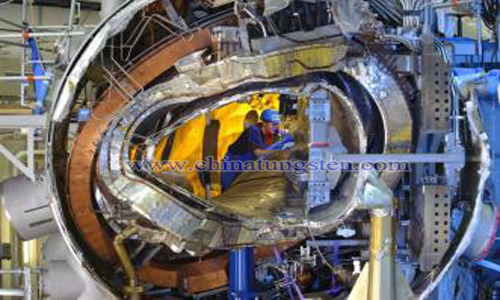Finishing of Tungsten-Copper Composite Block in Nuclear Fusion Unit
- Details
- Category: Tungsten Information
- Published on Sunday, 24 March 2019 17:21
In nuclear fusion devices, tungsten is considered as the most promising plasma-oriented material (PFM) because of its high melting point, low sputtering rate, high sputtering energy threshold and no reaction with hydrogen isotopes. The plasma-oriented component (PFC) composed of tungsten monolithic and chromium-zirconium-copper tube is the preferred method for preparing high heat load components of divertor target plate of fusion device.

Tungsten monolithic PFC is characterized by opening holes in tungsten monolithic, then coating an oxygen-free copper liner on the inner surface of tungsten monolithic holes to prepare tungsten/copper composite blocks, and finally connecting the chromium-zirconium-copper (Cu) tube through the holes with a group of tungsten/copper composite blocks. Tungsten monolithic PFC is also characterized by a certain width (0.5mm) gap between tungsten monolithic blocks, which is used to mitigate thermal stress and absorb strain. The fabrication of W-Cu composite block is very important, which has great influence on the assembly and connection of W-Cu composite block and chromium-zirconium-copper (Cu) pipe.
In order to achieve the above objectives, the researchers adopted the following methods to fabricate tungsten-copper composite blocks for high heat load components of nuclear fusion devices, which include the following steps:
(1)Hole in tungsten monolith;
(2)A 0.1 1 mm thick oxygen-free copper liner processed by hot isostatic pressing (or brazing or casting) is applied to the inner surface of tungsten monolithic openings.
(3)The oxygen-free copper lining protrudes a flanging step with a thickness of 0.1 mm and a width of 0.1 mm on one side of the tungsten block, and then combines the flanging step with the tungsten block by hot isostatic pressing (or brazing or casting).
The tungsten/copper composite block has a flanging step of 0.1 1mm thick and 0.1 5mm wide anaerobic copper liner on one side. It can play an accurate positioning role in the assembly process of multiple tungsten/copper composite blocks and heat sink cooling pipe, thus forming a gap of 0.1 1mm between tungsten blocks. More importantly, it is connected with tungsten/copper composite block and heat sink cooling water by subsequent HIP or expansion pipe diffusion welding (HRP). In the process of pipe technology, it can avoid large local deformation of heat sink cooling pipe between tungsten single clearance, thus greatly improving the overall connection quality and yield of nuclear fusion device.
- Tungsten Manufacturer & Supplier, Chinatungsten Online: www.chinatungsten.com
- Tungsten News & Prices of China Tungsten Industry Association: www.ctia.com.cn
- Molybdenum News & Price: news.molybdenum.com.cn
- Tel.: 86 592 5129696; Fax: 86 592 5129797; Email: sales@chinatungsten.com



 sales@chinatungsten.com
sales@chinatungsten.com